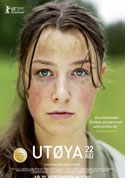

Opening 20 Sep 2018
Directed by:
Erik Poppe
Writing credits:
Siv Rajendram Eliassen, Anna Bache-Wiig
Principal actors:
Andrea Berntzen, Aleksander Holmen, Solveig Koløen Birkeland, Elli Rhiannon Müller Osbourne, Sorosh Sadat
Terrorist activities happen around the world but not in Norway or so they thought. On July 22, 2011, one of the most shocking events in Norwegian history happened which served as a wakeup call to change their security in the future. The film UTØYA 22.JULI (U-JULY 22) begins with documentary footage where rightwing extremist Andres Behring Brevik planted a bomb that killed eight people and injured another 209. At that point it is unclear who was responsible as chaos reigned, keeping the police busy trying to clarify this horrible tragedy. The next part of the film moves to the island where a group of some 500 hundred young people are attending a Worker Youth League (AUF) summer camp. Director Erik Poppe begins to roll the camera and in a 72-minute single take follows the viewpoint of 19-year-old Kaja (Andrea Berntzen) through the following events. We see her, her sister and her friends and, as the circle widens, the spectrum of people come into the eye of the camera. At first we feel their happiness, then their confusion, then fear, and finally all other thoughts which are evoked when being hunted down by this rightwing extremist who is only heard but never seen on camera.
From the beginning we see our reference point Kaja and know that she is highly responsible and very much integrated in the organizational team. She is searching for her disorganized fun-loving sister who just went for a swim. As they argue about their purpose for being there, we clearly see the difference between the sisters. One is competitive and wants to achieve a lot in her life whereas the other one feels overshadowed by her sister. They separate and soon Kaja meets others for lunch. That’s when they hear gunshots and with this hallowing sound, they scatter like frightened deer into the woods, hiding between trees and under rocks along the coast. The film shows that these kids had very little coverage on the island, making it easy for the heavily armed gunman to eliminate his victims, killing 69 and injuring another 110 before the police came to the rescue. In the footage we hear someone shouting that the press is hovering above in a helicopter but can’t help. Where are the police? We feel their desperation, their hope of a rescue, their anguish, their despair and finally their fear of death. The shots were at first far away but get closer and closer as Kaja sees people dying before her eyes.
The film emotionally affects us all as we think about all the people who have ever been a victim or witness of a shooting massacre. There are two elements that have to be changed in society. One is gun control, which in the US, is out of control. It is so obvious that it is a problem but somehow no one has the guts to stop it. The second one is mental health issues. Andres Behring Brevik was first diagnosed as having paranoid schizophrenia, but is now believed to have both antisocial and narcissistic personality disorders. He is currently in prison, unlike many of the other criminals who usually end up dead after their crazy killing spree. (Shelly Schoeneshoefer)